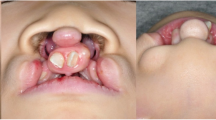Abstract
In unilateral cleft lip and palate, the orbicularis muscle, the alveolar bone, the floor of the nose, and the hard and soft palate are interrupted, creating an open communication between nasopharynx and oropharynx. Patients with a cleft lip and palate are treated in specialized cleft centers by a multidisciplinary team. Having cleft lip and/or palate has a noteworthy impact on quality of life and psychosocial functioning. Surgical scars are in the center of the face and can be quite noteworthy. Postoperative scarring is a common cause of patient dissatisfaction.
Here, we describe a patient with an unpleasing esthetic result after surgical correction of unilateral cleft lip and palate in China. After careful surgical planning, scar excision and a single Z-plasty were performed to achieve scar lengthening. Pre- and postoperative images are shown.
You have full access to this open access chapter, Download chapter PDF
Similar content being viewed by others
Keywords

A 11-year-old male visited the outpatient clinic with his parents because of unpleasing esthetic result after surgical correction of unilateral cleft lip and palate in China. There are no additional operative data available. The cleft palate and lip were not part of a genetic syndrome. There were no other comorbidities.
He stated that he was not pleased with the aesthetic result of the cleft surgery and that the main problem for him was asymmetry of the perioral area. There were no functional complaints in the domains of speech, eating, and/or drinking.
-
Q1. Define the problem in terms of anatomy
-
Q2. What is the Rose–Thompson effect?
-
Q3. What would be the surgical approach to this problem?
-
Q4. What (non)surgical methods can be chosen to optimize postoperative scarring?

Immediate postintervention situation: Correction of these deformities in children is best performed under general anesthesia. Intubation is performed using an RAE (Ring-Adair-Elwyn) tube , which is a prebent tube that facilitates adequate reach of the operative area. The operative area is marked using skin marker that does not wash away or fade out during sterile exposition and surgery. The operative region is infiltrated with a mix of lidocaine and adrenalin.
The scar was excised using a concave excision pattern, making use of the Rose–Thompson effect. With one additional Z-plasty , adequate scar length was achieved. Reconfiguration of misaligned lip mucosa was achieved in the same session. The subcutaneous plane was closed using resorbable sutures. The skin was closed using skin glue.
Argumented answers and explanation according to the five references (cited later): 20 lines
-
Q1. Define the problem in terms of anatomy.
-
A1. Postoperative scar contracture of philtral scar with subsequent effect on nose and lip esthetics. Also, misalignment of lip mucosa was observed.
-
Q2. What is the Rose–Thomson effect ?
-
A2. The effect of scar lengthening by using concave excisions of the scar, which is subsequently closed in a straight line
-
Q3. What would be the surgical approach to this problem?
-
A3. Use of the Rose–Thompson effect in combination with one or multiple Z-plasties or a combination of these strategies. An alternative approach might be using fat grafting of the scar; however, this probably provides a less predictable result.
-
Q4. What (non)surgical methods can be chosen to optimize postoperative scarring?
-
A4. Injecting the orbicularis oris with botulinum toxin , silicon application in the postoperative phase, using glue instead of sutures for tissue approximation.
-
Cleft lip scars influence lip, philtrum, and nose aesthetics.
-
In secondary lip correction, cleft surgeons typically make use of the Rose–Thompson effect, one or multiple Z-plasties, or a combination of these strategies.
Suggested Reading
Deshmukh M, Vaidya S, Deshpande G, Galinde J, Natarajan S. Comparative evaluation of esthetic outcomes in unilateral cleft lip repair between the Mohler and fisher repair techniques: a prospective, randomized, observer-blind study. J Oral Maxillofac Surg. 2019;77(1):182.e1–8.
Farmand M. Secondary lip correction in unilateral clefts. Facial Plast Surg. 2002;18(3):187–95.
Mulliken JB, Zhu DR, Sullivan SR. Outcomes of cleft lip repair for internationally adopted children. Plast Reconstr Surg. 2015;135(5):1439–47.
Stal S, Hollier L. Correction of secondary cleft lip deformities. Plast Reconstr Surg. 2002;109(5):1672–81.
Author information
Authors and Affiliations
Corresponding author
Editor information
Editors and Affiliations
Rights and permissions
Open Access This chapter is licensed under the terms of the Creative Commons Attribution 4.0 International License (http://creativecommons.org/licenses/by/4.0/), which permits use, sharing, adaptation, distribution and reproduction in any medium or format, as long as you give appropriate credit to the original author(s) and the source, provide a link to the Creative Commons license and indicate if changes were made.
The images or other third party material in this chapter are included in the chapter's Creative Commons license, unless indicated otherwise in a credit line to the material. If material is not included in the chapter's Creative Commons license and your intended use is not permitted by statutory regulation or exceeds the permitted use, you will need to obtain permission directly from the copyright holder.
Copyright information
© 2020 The Author(s)
About this chapter
Cite this chapter
van der Sluis, W.B., Don Griot, J.P.W. (2020). Secondary Lip Correction in a Cleft Lip Patient. In: Téot, L., Mustoe, T.A., Middelkoop, E., Gauglitz, G.G. (eds) Textbook on Scar Management. Springer, Cham. https://doi.org/10.1007/978-3-030-44766-3_64
Download citation
DOI: https://doi.org/10.1007/978-3-030-44766-3_64
Published:
Publisher Name: Springer, Cham
Print ISBN: 978-3-030-44765-6
Online ISBN: 978-3-030-44766-3
eBook Packages: MedicineMedicine (R0)



